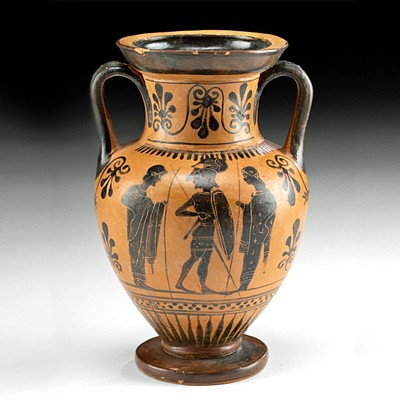Roman Marble Sarcophagus Panel w/ Theater Mask
Lot 66
About Seller
Artemis Fine Arts
686 S Taylor Ave, Ste 106
Louisville, CO 80027
United States
Selling antiquities, ancient and ethnographic art online since 1993, Artemis Gallery specializes in Classical Antiquities (Egyptian, Greek, Roman, Near Eastern), Asian, Pre-Columbian, African / Tribal / Oceanographic art. Our extensive inventory includes pottery, stone, metal, wood, glass and textil...Read more
Estimate:
$10,000 - $15,000
Absentee vs Live bid
Two ways to bid:
- Leave a max absentee bid and the platform will bid on your behalf up to your maximum bid during the live auction.
- Bid live during the auction and your bids will be submitted real-time to the auctioneer.
Bid Increments
| Price | Bid Increment |
|---|---|
| $0 | $25 |
| $300 | $50 |
| $1,000 | $100 |
| $2,000 | $250 |
| $5,000 | $500 |
| $10,000 | $1,000 |
| $20,000 | $2,500 |
| $50,000 | $5,000 |
| $100,000 | $10,000 |
| $200,000 | $20,000 |
About Auction
By Artemis Fine Arts
Mar 9, 2023
Set Reminder
2023-03-09 10:00:00
2023-03-09 10:00:00
America/New_York
Bidsquare
Bidsquare : Exceptional Ancient, Ethnographic, & Fine Art
https://www.bidsquare.com/auctions/artemis-gallery/exceptional-ancient-ethnographic-fine-art-12354
Artemis Fine Arts info@artemisfinearts.com
Artemis Fine Arts info@artemisfinearts.com
- Lot Description
**First Time At Auction**
Roman, Imperial period, probably Phrygia (modern Turkey), ca. 2nd to 3rd century CE. A breathtaking marble sarcophagus panel, festooned with garlands of oak leaves supported by 2 nude putti with the theater mask of tragedy featured at the center. A tongued pattern, perhaps intended as acorns, adorns the top periphery, as scrolling ribbons fly out from the garland. The lush foliage of the garlands was intended to represent actual swags of leaves and fruit that would decorate altars and tombs, and also to symbolize a promise for eternal bountiful fruition and abundance. Similarly, the theater mask alluded to Bacchus - Greek Dionysus - the patron god of the theater who was associated with rebirth. Although this piece possesses some age wear as shown, it is remarkable that it survived the onslaught of the early Christian campaigns that destroyed so many exceptional examples of so-called pagan art! Size: 28.9" L x 7.1" W x 14.1" H (73.4 cm x 18 cm x 35.8 cm)
As in Greece, masks played an important role in Roman theatre. An actor's entire head and hair would be covered by a large mask of simple design, made from linen or cork, with holes for the mouth and eyes. These masks allowed audience members seated in all areas of the theatre to understand what was happening, while also amplifying the actor's voice. Romans appreciated all forms of entertainment and there were hundreds of playwrights in ancient Rome. Plays were performed to honor the gods during religious ceremonies, and since Rome had over 200 religious days of commemoration each year, plays were performed many days of the year.
The word sarcophagus literally means "flesh-eater" in Greek. Sarcophagi were coffins used throughout the Roman Empire beginning in the second century CE when inhumation burials became more popular than cremation practices of the Republican and early Imperial periods. The rise in sarcophagi usage was inspired by earlier Etruscan and Greek models. This example came from a particularly luxurious sarcophagus as it was made from marble. Less elite examples were made from other stones, wood, and lead. Roman sarcophagi featuring garlands were also quite popular in ancient Rome, with many being made in Phrygia (modern-day Turkey) and shipped throughout the empire. A wonderful section of a marble sarcophagus intended for an elite individual of ancient Rome.
For similar marble sarcophagi panels, please see the Metropolitan Museum of Art (70.1), Walters Art Museum (23.29), and Getty Institute (72.AA.152).
PLEASE NOTE: Due to recent increases of shipments being seized by Australian & German customs (even for items with pre-UNESCO provenance), we will no longer ship most antiquities and ancient Chinese art to Australia & Germany. For categories of items that are acceptable to ship to Australia or Germany, please contact us directly or work with your local customs brokerage firm.
Provenance: East Coast collection, New York Gallery, New York City, New York, USA, acquired before 2010
All items legal to buy/sell under U.S. Statute covering cultural patrimony Code 2600, CHAPTER 14, and are guaranteed to be as described or your money back.
A Certificate of Authenticity will accompany all winning bids.
We ship worldwide and handle all shipping in-house for your convenience.
#177231Fragment of a larger piece with expected chipping and losses to peripheries and face of putto on side. Otherwise, excellent with impressive preservation of detail.Condition
- Shipping Info
-
All shipping is handled in-house for your convenience. Your invoice from Artemis Gallery will include shipping calculation instructions. If in doubt, please inquire BEFORE bidding for estimated shipping costs for individual items.
-
- Buyer's Premium



 EUR
EUR CAD
CAD AUD
AUD GBP
GBP MXN
MXN HKD
HKD CNY
CNY MYR
MYR SEK
SEK SGD
SGD CHF
CHF THB
THB
















